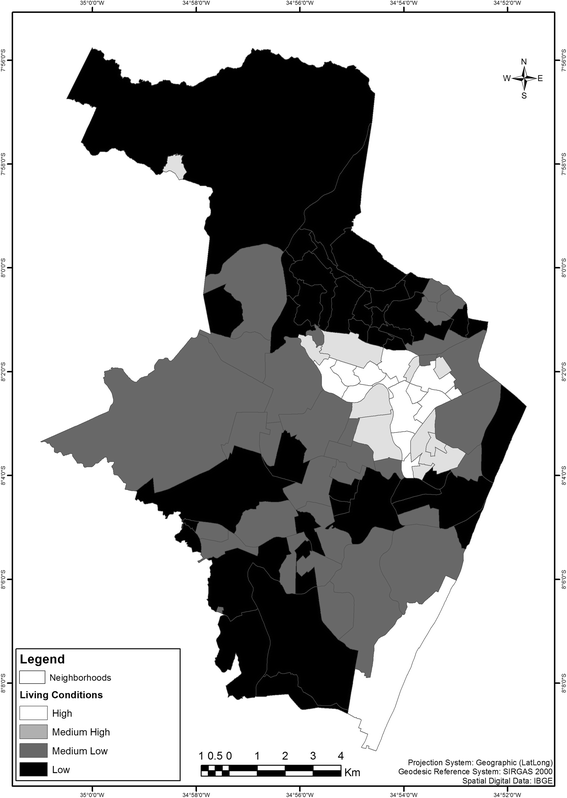Microcephaly epidemic related to the Zika virus and living conditions in Recife, Northeast Brazil
- PMID: 29329574
- PMCID: PMC5767029
- DOI: 10.1186/s12889-018-5039-z
Microcephaly epidemic related to the Zika virus and living conditions in Recife, Northeast Brazil
Abstract
Background: Starting in August 2015, there was an increase in the number of cases of neonatal microcephaly in Northeast Brazil. These findings were identified as being an epidemic of microcephaly related to Zika virus (ZIKV) infection. The present study aims to analyse the spatial distribution of microcephaly cases in Recife (2015-2016), which is in Northeast Brazil, and its association with the living conditions in this city.
Methods: This was an ecological study that used data from reported cases of microcephaly from the State Health Department of Pernambuco (August 2015 to July 2016). The basic spatial unit of analysis was the 94 districts of Recife. The case definition of microcephaly was: neonates with a head circumference of less than the cut-off point of -2 standard deviations below the mean value from the established Fenton growth curve. As an indicator of the living conditions of the 94 districts, the percentage of heads of households with an income of less than twice the minimum wage was calculated. The districts were classified into four homogeneous strata using the K-means clustering algorithm. We plotted the locations of each microcephaly case over a layer of living conditions.
Results: During the study period, 347 microcephaly cases were reported, of which 142 (40.9%) fulfilled the definition of a microcephaly case. Stratification of the 94 districts resulted in the identification of four strata. The highest stratum in relation to the living conditions presented the lowest prevalence rate of microcephaly, and the overall difference between this rate and the rates of the other strata was statistically significant. The results of the Kruskal-Wallis test demonstrated that there was a strong association between a higher prevalence of microcephaly and poor living conditions. After the first 6 months of the study period, there were no microcephaly cases recorded within the population living in the richest socio-economic strata.
Conclusion: This study showed that those residing in areas with precarious living conditions had a higher prevalence of microcephaly compared with populations with better living conditions.
Keywords: Brazil; Ecological study; Socio-economic; Zika.
Conflict of interest statement
Author information
The investigators are from the Microcephaly Epidemic Research Group, Brazilian Ministry of Health, Pan American Health Organization and State Health Department of Pernambuco.
Ethics approval and consent to participate
We received permission of Pernambuco Health State Department to use the anonymous data for research purpose.
Consent for publication
Not applicable.
Competing interests
We declare that there are no competing interests to disclose.
Publisher’s Note
Springer Nature remains neutral with regard to jurisdictional claims in published maps and institutional affiliations.
Figures
Comment in
-
The COVID-19 pandemic in Brazil built on socioeconomic and political pillars.Pathog Glob Health. 2021 Mar;115(2):75-77. doi: 10.1080/20477724.2021.1874202. Epub 2021 Jan 14. Pathog Glob Health. 2021. PMID: 33446084 Free PMC article. No abstract available.
References
-
- Steffens I, Wilson K. Chikungunya and Zika virus Special edition. Eurosurveillance. 2014; October:74.
-
- Musso D, Gubler DJ. Zika Virus. Nature. 2016;11:10–20.
Publication types
MeSH terms
Grants and funding
LinkOut - more resources
Full Text Sources
Other Literature Sources
Medical
Research Materials




